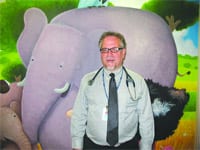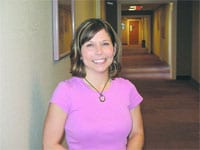Baystate Uses Innovative Surgery on Child with Pancreatic Pseudocyst
SPRINGFIELD — Members of a pediatric surgical team at Baystate Children’s Hospital were recognized for their collaborative and creative approach in the use of new NOTES technology to operate on a young child with a pancreatic pseudocyst.
Dr. Kevin Moriarty of Pediatric Surgical Services in Springfield and Dr. Anastasios Angelides of Baystate Pediatric Gastroenterology and Nutrition had their paper, “Hybrid NOTES: Incisionless Intragastric Stapled Cystgastrostomy of a Pancreatic Pseudocyst,” published in the February issue of the Journal of Pediatric Surgery. Dr. Connie Rossini of Baystate Medical Center’s Surgical Education Department also served as an author of the paper.
The innovative surgery at Baystate furthers the medical staff’s embrace of new technology and innovative procedures such as NOTES, which is still in the pioneering stages, to benefit patients of all ages.
The emerging field of NOTES (natural orifice translumenal endoscopic surgery) is a cutting-edge surgical and gastroenterological approach which involves passing flexible surgical tools and a camera through the patient’s natural orifices to eliminate incisions, resulting in less pain, infection, and quicker recoveries. In addition, many patients who are high-risk candidates for surgery may be able to be treated with this new, less-invasive surgical approach.
Open surgery, which relies on an incision large enough in the patient to allow a direct view of the operating field and insertion of surgical instruments, was for years the most common form of surgery. Now, advanced instrumentation has led to improved visualization, access, and diagnostic capability with the use of smaller incisions known as minimally invasive surgery. The technique has replaced many surgeries once performed only by large incisions.
Most recently, the evolution of NOTES is ushering in yet a new era to benefit patients by offering surgeons an even less-invasive approach to surgery involving procedures performed through natural openings such as the mouth, vagina, or anus instead of the abdominal ports used in minimally invasive surgery.
“NOTES-spectrum surgery will undoubtedly become more common over time,” Angelides said, “and as a crucial corollary we can expect the development of new instrumentation to facilitate these procedures.”
The patient, a 7-year-old boy, had acute pancreatitis and developed a 9-centimeter pancreatic pseudocyst not often seen in children — the size of a softball pushing against his stomach and intestines — which failed to resolve after six weeks. A pseudocyst is an accumulation of fluid in a cyst-like cavity in the body.
Other medical complications, including a history of multiple abdominal surgeries leaving scarring in the area, did not make the child a good candidate for an invasive surgical procedure. As a result, the pediatric surgical team decided to use an innovative NOTES procedure — performed several years ago on an adult at Baystate Medical Center — utilizing only the patient’s mouth enabled by a computer-powered surgical stapling system to reach the surgical site.
“Using a gastroscope as our eyes and passing it through his mouth and into the stomach, the surgery was conducted through the child’s pre-existing feeding tube without the need to make any incisions,” said Moriarty — thus the term ‘hybrid NOTES.’
“We were able to create an opening between the large cyst and the boy’s stomach and staple the two together to prevent bleeding, draining the cyst and preventing the cyst from coming back,” he added.
The patient did well postoperatively and had a dramatic reduction in size of the pseudocyst to 3.5 centimeters within two weeks. Since the operation, Moriarty has used a modification of the technique for another complex stomach surgery in a child.
Angelides noted that the key to successful NOTES or hybrid NOTES is “a close interdisciplinary collaboration between the surgeon and gastroenterologist. Patients must be selected very carefully, on an individual basis, and with due consideration to the alternative procedures available to the patient.”


